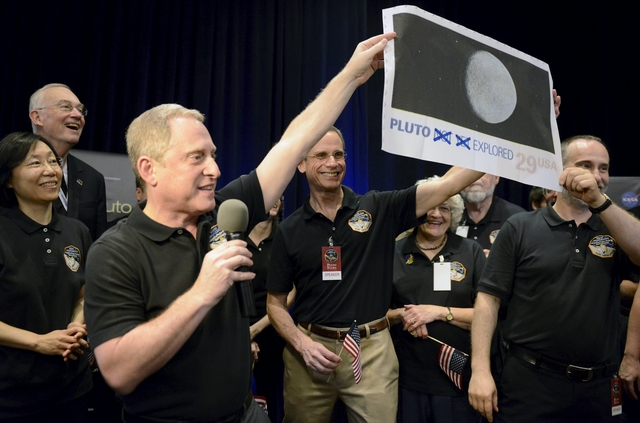A U.S. spacecraft sailed past the tiny planet Pluto in the distant reaches of the solar system on Tuesday, capping a journey of 3 billion miles (4.88 billion km) that began nine and a half years ago.
NASA's New Horizons spacecraft passed by the ice-and-rock planetoid and its entourage of five moons at 7:49 a.m. EDT (1149 GMT). The event culminated an initiative to survey the solar system that the space agency embarked upon more than 50 years ago.
About 13 hours after its closest approach to Pluto, the last major unexplored body in the solar system, New Horizons phoned home, signaling that it had survived its 31,000 miles per hour(49,000 km per hour) blitz through the Pluto system.
Managers had estimated there was a 1-in-10,000 chance a debris strike could destroy New Horizons as it soared just 7,750 miles (12,472 km) - about the distance from New York to Mumbai - from Pluto.
But right on time, New Horizons made radio contact with flight controllers at the Johns Hopkins University Applied Physics Lab outside Baltimore, sparking a wave of shouts and applause from an overflow crowd gathered to watch the drama unfold.
With 99 percent of the data gathered during the encounter still on the spaceship, New Horizons' survival was critical to the mission.
"This is truly a hallmark in human history," said John Grunsfeld, NASA's associate administrator for science.
New Horizons spent more than eight hours after its closest approach looking back at Pluto for a series of experiments to study the planet's atmosphere and photograph its night-side using light reflected off its primary moon Charon.
Sending back its first post-flyby signal took another 4½ hours, the time it takes radio signals, traveling at light speed, to travel the 3 billion miles (4.88 billion km) back to Earth.
Already, the trickle of images and measurements relayed from New Horizons before Tuesday's pass by Pluto has changed scientists' understanding of this diminutive world, which is smaller than Earth's moon.
Once considered an icy, dead world, the planetoid has yielded signs of geological activity, with evidence of past and possibly present-day tectonics, or movements of its crust.
"This is clearly a world where both geology and atmosphere climatology play a role," said Alan Stern, New Horizons lead scientist, with the Southwest Research Institute in Boulder, Colorado. He noted that it appears that nitrogen and methane snow fall on Pluto.
Pluto circles the sun every 248 years in a highly tilted orbit that creates radical changes from season to season. Pluto travels closer to the sun than the orbit of Neptune before it cycles back into the solar system's deep freeze more than 40 times farther away than Earth.
Scientists have many questions about Pluto, which was still considered the solar system's ninth planet when New Horizons was launched in 2006. Pluto was reclassified as a "dwarf planet" after the discovery of other Pluto-like spheres orbiting in the Kuiper Belt, the region beyond the eighth planet, Neptune. The objects are believed to be remnants from the formation of the solar system 4.6 billion years ago.
"Now the solar system will be further opened up to us, revealing the secrets of distant Pluto," British cosmologist Stephen Hawking said in a message broadcast on NASA TV.
"We explore because we are human and we want to know. I hope that Pluto will help us on that journey," Hawking said.
It will take about 16 months for New Horizons to transmit back all the thousands of images and measurements taken during its pass by Pluto. By then, the spacecraft will have traveled even deeper into the Kuiper Belt, heading for a possible follow-on mission to one of Pluto's cousins.




















































